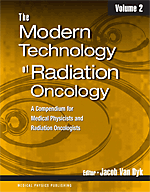
The Modern Technology of Radiation Oncology, Vol 2
Author: Jacob Van Dyk, editorISBN: 9781930524255 ISBN10: 1930524250
Published: 2005 | 514 pp | Hardcover
Price: $ 120.00
Australasian Physical and Engineering Sciences in Medicine | 2008
Most radiation oncology physicists will be familiar with Jacob Van Dyk’s epic work, The Modern Technology of Radiation Oncology, published in 1999. With its comprehensive coverage of the field and practical recommendations, it has proved to be an invaluable reference for students and practicing physicists alike.
According to the preface, the second volume was written to “describe the significant incremental advances over the past 5 years”. It is a much smaller book than the massive first volume, and does not cover the same range of topics. Rather it brings Volume 1 up to date with additional material on the use of imaging in radiotherapy planning and treatment verification, intensity modulated radiotherapy and prostate brachytherapy. There are also some completely new chapters covering Monte Carlo dose calculation, the use of breathing control in radiotherapy, radiobiological modeling and absolute dose calibration.
Imaging is an area undergoing rapid expansion in radiotherapy departments, with a variety of new imaging modalities coming into routine use. Chapter 2 focuses on the imaging techniques used to assist with tumour localization for treatment planning. Large-bore, multi-slice CT, MRI, PET, SPECT and ultrasound are all described. Chapter 7 covers the use of X-ray imaging for treatment verification, including electronic portal imaging, megavoltage and kilovoltage cone beam CT. Both chapters include specific advice about purchase, acceptance testing and quality assurance, with particular reference to the requirements of radiation oncology departments.
With Monte Carlo (MC) algorithms now being supplied on some commercial planning computers, the inclusion of a chapter on MC calculations is very timely. The first part of the chapter describes the basic concepts of MC dose calculation, including input data requirements and variance reduction techniques. The second part of the chapter focuses on the application of Monte Carlo to patient dose calculations, including clinical examples of photon, electron and IMRT plans. Particularly useful to the novice faced with commissioning a commercially supplied MC algorithm are the sections discussing the uncertainties involved in MC calculations, and giving specific recommendations about commissioning MC algorithms.
Two chapters address developments in Intensity Modulated Radiotherapy (IMRT). While there is some overlap in the material covered in Chapters 4 and 6, the former concentrates on inverse treatment planning, while the latter deals with IMRT delivery systems and QA procedures as well as treatment planning. In Chapter 4, a thorough discussion of the various parameters that control optimization algorithms during inverse planning is very helpful in understanding this sometimes confusing issue.
The chapter on radiobiological modeling gives a logical overview of the different approaches to calculation of tumour control and normal tissue complication probabilities. By putting the information into an historical context, the authors show how knowledge of basic radiobiology is advancing, but also point out the limitations of current understanding and the need for caution in the use of radiobiological data.
Chapter 9 discusses calibration of megavoltage radiation beams. The first part of this chapter, where the basic concepts of absolute dosimetry are reviewed, differs from most of the rest of the book in that it presents material that is already covered in standard medical physics text books. However the easy-to-read language and excellent use of diagrams make this section valuable reading for the medical physics student. The subsequent parts of the chapter include full discussions and comparisons of IAEA protocols TRS 277 and TRS 398, together with AAPM protocols TG21 and TG51.
The chapter on the use of breathing control in radiotherapy planning and treatment describes methods for quantifying respiratory motion. The impact of motion on patient dose delivery and methods for minimizing this are discussed. Those working in prostate brachytherapy or planning to develop a prostate brachytherapy program will find Chapter 10 of interest. There is a good summary of the basics of planning and treating with both high dose rate brachytherapy and low dose rate permanent seed implants.
Overall the book gives a very impressive coverage of the current state of radiation oncology. Anyone fully conversant with all the material in the book would be well qualified indeed. Because of its focus on new technologies and techniques, some parts of the book will inevitably become out of date over the next few years. I can only hope that Jacob Van Dyk and his team of authors will continue to produce new or revised volumes as time goes by.
This is not a beginner’s textbook—a fair amount of general knowledge about medical physics and radiation oncology is assumed. In some chapters, references to material covered in the first volume could be frustrating to those without access to the earlier book. However overall the style is readable and the book is well laid out. The book really meets a need for the practicing medical physicist faced with the task of understanding, purchasing, commissioning or otherwise working with unfamiliar technologies or concepts. By reading the relevant chapter of this book, you get a comprehensive overview of the relevant topic. The huge list of references included with each chapter assists the reader to follow up on topics on which further detail is desired.
Although the preface says that the book is designed for both radiation oncologists and medical physicists, I feel that the strong technical focus will sit more comfortably with medical physics readers. However, advanced medical physics trainees, radiation therapists and radiation oncologists will also find the book useful. The Modern Technology of Radiation Oncology, Volume 2 definitely deserves a place in the library of all radiation oncology departments.
Anne Perkins
Bendigo Radiotherpy Centre
Victoria, Australia
